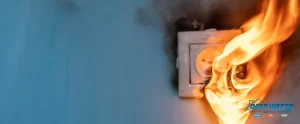Smoke damage makes property remediation after a fire a bit more complicated. Smoke consists of carbon dioxide, carbon monoxide, and soot, mixing with other hazardous chemicals that affect air quality. It can irritate your eyes, nose and affect breathing. Furthermore, smoke can also leave strong odors and coat walls, furniture, and fabric.
Smoke damage from a fire can be as harmful as the fire itself. Once fire spreads, it destroys property and leaves areas with smoke damage in the aftermath. Fortunately, not all is lost after a fire or smoke damage in houses. Mitigation experts at Deep Water Emergency Services & Mitigation have the right equipment and best practices for cleaning smoke damage.
A Closer Look At Smoke Damage
Smoke damage is often confused with destruction from fire; however, it is the physical or structural ruination of property caused by smoke. Smoke has acidic components, leaving an unpleasant smell and coating your walls, furniture, and fixtures with a layer of grease – making it a challenge to clean it thoroughly.
Smoke is a sly enemy, and it travels even in unlikely places. It can reach the vents, light fixtures, electrical sockets, walls, and your furnishings. Smoke particles are invisible to the naked eye and are a health hazard.
What Are the Common Items Affected by Smoke Damage From Fire?
Plastic
Smoke causes discoloration on things made of plastic. If you can, you should wipe down the plastic immediately if you have an alkaline-based cleaning agent.
Appliances
Your refrigerator, oven, television, washing machine, and other appliances are prone to electrical system damage. Smoke can penetrate their interior.
Carpets
Smoke will also get to your synthetic rugs or carpets. It will take days before permanent stains settle in. You might get to use it again if fire, water, and any chemicals used to extinguish the fire didn’t settle on it. Immediate cleaning is a must.
Curtains and Upholstery
Smoke will also leave yellow stains on your curtains and upholstery. They will need a special cleaning solution to remove smoke particles and prevent permanent staining.
Hardwood Floors
Hardwood floors are highly porous, allowing soot and smoke particles to find and settle on them quickly. If the damage is not that extensive, deodorizing and mopping the floors should be adequate. For severe damage, refinishing the floor or even replacing it entirely might be necessary.
Wood and Metal Furniture
Cleaning off the soot and smoke in wood furniture is complicated. You need to use the right cleaning agents to avoid stripping off the varnish, wood stains, and paint. The same goes with metal furniture; using the wrong cleaning agent may result in rusting.
What Can You Salvage?
Mitigation experts know whether an item is worth salvaging or not. Professionals will sort your things into three categories: what can be cleaned, what should be discarded, and what should be replaced.
Contact Deep Water Emergency Services & Mitigation Today!
Aside from calling firefighters to the scene, saving our contact information will also come in handy when it comes to mitigation. We know how to clean smoke damage properly. Not only that, but you can also call us for water damage mitigation services in Omaha, NE. Return to your home without worries!






